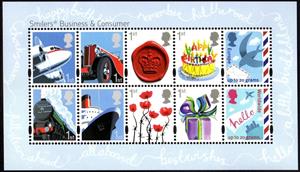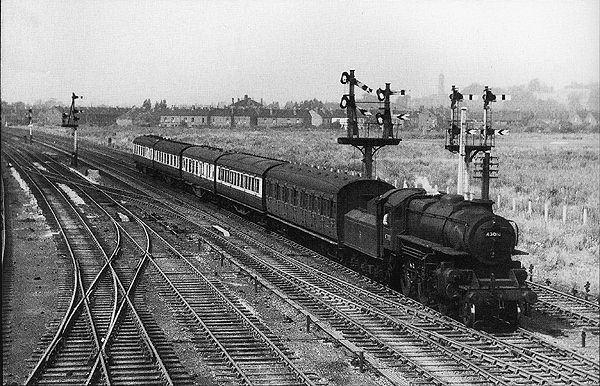Souvenir Sheet: Smilers (United Kingdom of Great Britain & Northern Ireland 2010)
Smilers (United Kingdom of Great Britain & Northern Ireland 2010)
26 January (United Kingdom of Great Britain & Northern Ireland ) within release Smilers goes into circulation Souvenir Sheet Smilers face value 4.19 British pound sterling
| Souvenir Sheet Smilers in catalogues | |
|---|---|
| Stanley Gibbons: | Sg:GB MS3024 |
Souvenir Sheet is square format.
Printed by CartorAlso in the issue Smilers:
- Stamp - Airplane face value 1st Class;
- Stamp - Vintage Car face value 1st Class;
- Stamp - Seal face value 1st Class;
- Stamp - Birthday Cake face value 1st Class;
- Stamp - Wrapped Present face value 1st Class;
- Stamp - Steam Locomotive face value 1st Class;
- Stamp - Ocean Liner face value 1st Class;
- Stamp - Poppies face value 1st Class;
- Stamp - Europe face value 20;
- Stamp - Worldwide face value Worldwide 20g;
- Stamp - Airplane face value 1st Class;
- Stamp - Vintage Car face value 1st Class;
- Stamp - Seal face value 1st Class;
- Stamp - Birthday Cake face value 1st Class;
- Stamp - Wrapped Present face value 1st Class;
- Stamp - Steam Locomotive face value 1st Class;
- Stamp - Ocean Liner face value 1st Class;
- Stamp - Poppies face value 1st Class;
- Stamp - Europe face value 20;
- Stamp - Worldwide face value Worldwide 20g;
- Souvenir Sheet - Smilers face value 4.19;
Souvenir Sheet Smilers it reflects the thematic directions:
A ship is a large watercraft that travels the world's oceans and other sufficiently deep waterways, carrying passengers or goods, or in support of specialized missions, such as defense, research and fishing. Historically, a "ship" was a sailing vessel with at least three square-rigged masts and a full bowsprit. Ships are generally distinguished from boats, based on size, shape and load capacity.
A flower, sometimes known as a bloom or blossom, is the reproductive structure found in plants that are floral (plants of the division Magnoliophyta, also called angiosperms). The biological function of a flower is to effect reproduction, usually by providing a mechanism for the union of sperm with eggs. Flowers may facilitate outcrossing (fusion of sperm and eggs from different individuals in a population) or allow selfing (fusion of sperm and egg from the same flower). Some flowers produce diaspores without fertilization (parthenocarpy). Flowers contain sporangia and are the site where gametophytes develop. Many flowers have evolved to be attractive to animals, so as to cause them to be vectors for the transfer of pollen. After fertilization, the ovary of the flower develops into fruit containing seeds. In addition to facilitating the reproduction of flowering plants, flowers have long been admired and used by humans to beautify their environment, and also as objects of romance, ritual, religion, medicine and as a source of food.
Birds (Aves), a subgroup of Reptiles, are the last living examples of Dinosaurs. They are a group of endothermic vertebrates, characterised by feathers, toothless beaked jaws, the laying of hard-shelled eggs, a high metabolic rate, a four-chambered heart, and a strong yet lightweight skeleton. Birds live worldwide and range in size from the 5 cm (2 in) bee hummingbird to the 2.75 m (9 ft) ostrich. They rank as the class of tetrapods with the most living species, at approximately ten thousand, with more than half of these being passerines, sometimes known as perching birds. Birds are the closest living relatives of crocodilians.
A car is a wheeled, self-powered motor vehicle used for transportation and a product of the automotive industry. Most definitions of the term specify that cars are designed to run primarily on roads, to have seating for one to eight people, to typically have four wheels with tyres, and to be constructed principally for the transport of people rather than goods. The year 1886 is regarded as the birth year of the modern car. In that year, German inventor Karl Benz built the Benz Patent-Motorwagen. Cars did not become widely available until the early 20th century. One of the first cars that was accessible to the masses was the 1908 Model T, an American car manufactured by the Ford Motor Company. Cars were rapidly adopted in the United States of America, where they replaced animal-drawn carriages and carts, but took much longer to be accepted in Western Europe and other parts of the world.
Railways - Transportation system made up of metal rails which is designed to allow trains to maneuver on the tracks from one location to the next.
Aviation is the practical aspect or art of aeronautics, being the design, development, production, operation and use of aircraft, especially heavier than air aircraft. The word aviation was coined by French writer and former naval officer Gabriel La Landelle in 1863, from the verb avier (synonymous flying), itself derived from the Latin word avis ("bird") and the suffix -ation.
An aircraft is a machine that is able to fly by gaining support from the air. It counters the force of gravity by using either static lift or by using the dynamic lift of an airfoil, or in a few cases the downward thrust from jet engines. The human activity that surrounds aircraft is called aviation. Crewed aircraft are flown by an onboard pilot, but unmanned aerial vehicles may be remotely controlled or self-controlled by onboard computers. Aircraft may be classified by different criteria, such as lift type, aircraft propulsion, usage and others.







